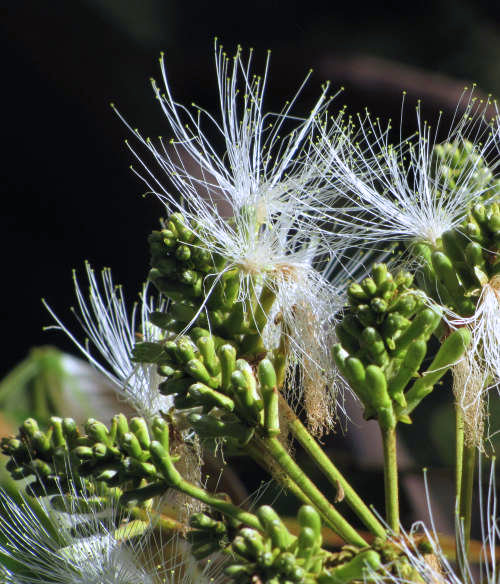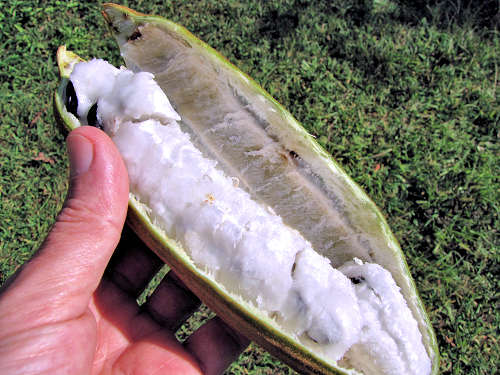Growing Ice Cream Bean / Pacay:
Inga feuilleei
Back to Fruit, Berries and Nuts
Botanical Overview
A member of the Legume family (Fabaceae), known for its nitrogen-fixing roots, the Inga genus is a group of 381 tropical shrubs and trees. Several species have edible, tasty seedpod filling and are known as Ice Cream Bean. Of these, Inga feuilleei, Pacay, is the most cold hardy, heat tolerant, and most widely cultivated. Inga edulis, often cited as the best tasting, has a restricted cultivation range. Inga feuilleei is considered nearly as flavorful.
Description
Form:
A tree with a rounded-depressed, spreading canopy.
Lifespan:
Perennial.
Leaf retention:
Evergreen but cold-deciduous. It may start to drop leaves below 40°F (4.4°C).
Growth rate:
Rapidly growing in warm, rainy regions, it may be slow during its first year in the ground,
then develop faster in subsequent years with sufficient water.
Mature Size:
20-40' (6-12m) high and as wide in dry climates, it easily reaches 40-100' (12-30m) in its
native environment.
Flowers:
A tuft of white stamens extend from a light green tube of five fused petals. The flowers are
clustered at the end of flowering stems.
Bloom:
Spring.
Self-fruitful:
Perhaps, although the trees in this genus are usually not. A second tree will improve
productivity.
Years before fruiting:
5-7 years from seed.
Fruit:
A bean pod, with four sides and four rolled edges, 8-24" (21-60cm) long and 2-3" (5-7.6cm)
wide, having a white fibrous filling surrounding hard seeds. The filling is eaten raw and
tastes like juicy cotton candy, sometimes with a hint of vanilla. The seeds can be cooked
and eaten as a vegetable. The seeds often sprout inside the pod when it becomes ripe.
Months for fruit to ripen:
2 or more. The bean pods are ripe when the edges start to yellow while the sides are still
green.
Storage after harvest:
The bean pod filling can last up to five days at room temperature after harvest, but tastes
even better refrigerated.
The filling is perishable and should be consumed immediately after the bean pod is opened.
Leaves:
Dark green, 3-4 pairs of leaflets per cluster, with winged leaf stalks.
Moderate to dense shade.
Plants in the genus Inga have nectaries (nectar producing glands) on their leaves, producing
nectar during leaf development to attract beneficial insects like parasitic wasps and ants.
Stems:
No thorns.
Roots:
Nitrogen-fixing.* This tree tends to develop root suckers.
Wildlife:
The flowers attract bees, butterflies, and hummingbirds. Beneficial insects, including ants,
are attracted to the nectaries on young leaves, and protect growing leaves from herbivores.
Mature leaves are browsed by mammals, and are used to feed livestock. Bean pods are consumed
by mammals, and the contents of open pods attract birds.
Toxic / Danger:
The seeds must be roasted or boiled to become edible.
Origin:
Peru.
Cultivation and Uses
USDA hardiness zones:
10-12. Young plants are damaged at 32°F (0°C), older plants are damaged at 29°F
(-1.7°C) but survive to 25°F (-3.9°C), although with limb dieback.
Protect from freezing wind.
Chill hours:
None.
Heat tolerant:
This tree needs afternoon shade and extra water over 90°F (32°C).
Drought tolerant:
Not without loss of fruit crop. This plant is native to moderate and high rainfall regions
but becomes drought tolerant with age. It will need extra water in high temperatures and
should be kept away from drying wind.
Sun:
Full morning sun with deciduous afternoon shade. Trees with too much shade become spindly
and flower less.
Planting:
Locate this tree where it will receive full morning sun with deciduous afternoon shade and
is protected from wind. It must have a southern exposure with full sun in winter and must
not be near a low lying spot where cold air collects in winter. Space trees 16' (5m) apart
when planting more than one.
Soil:
This tree needs well draining soil, with a range of pH 5.1-7.8 (strongly acidic to slightly
alkaline).
It is tolerant of soil conditions otherwise, and some varieties tolerate flooding.
Fertilize:
*Do not use a nitrogen fertilizer. In alkaline soil, fertilize at the drip line, mid-winter,
mid-spring and mid-summer, with a source of potassium and magnesium.
Iron and zinc supplements may also be needed mid spring or mid summer.
Water these mineral supplements into the soil; do not foliar feed.
Water after becoming established:
Irrigate the entire root area, using basin irrigation
at least twice a week, when flowering and fruiting.
The tree does better with high humidity, and extra water during hot, dry days is beneficial.
Deep watering will encourage deeper roots better
able to handle heat and drought.
Insufficient water is signaled by brown leaf tips and dropped leaves.
Mulch:
Apply mulch inside the drip line and 8" (21cm) away from the trunk to retain soil moisture and
moderate soil temperatures.
First Year Care:
Protect from freezing and strong winds. Deep water twice a week or more, depending on temperature,
especially in the first three weeks.
Prune:
This tree can be shaped, and can be severely pruned after 4 years in the ground to maintain a
low canopy.
Litter:
Seed pod drop.
Propagation:
Air layering is very successful. Leafy, woody cuttings grown in a mist environment are about
50% successful. Seed are viable only for a few weeks unless refrigerated, often sprout inside
the ripe pod, and are not viable dried. Ripe, unopened pods, sold online and delivered
quickly, may be a way to obtain viable seeds. The seeds may be polyembryonic and may grow
true to the parent. Root suckers can also be used for clonal reproduction.
Pests:
Mosaic Virus and Witches Broom.
Uses:
Seedpods with edible filling, seeds that are edible when cooked, shade for food crops,
nitrogen fixing in soils in which it grows, and when cut low (pollarded), forage for cattle.
Comments
Inga genus plants are distantly related to other Legume family members with edible bean pods
or filling, such as Carob,
Guamuchil, and
Tamarind.
This website uses World Flora Online
as the authority for plant species names and spelling.
Do you have additional information or a different experience for these plants that you would like to share? Email info@GardenOracle.com. All contributions are welcome and appreciated.
Do you have additional information or a different experience for these plants that you would like to share? Email info@GardenOracle.com. All contributions are welcome and appreciated.



Latest update: November, 2024
© 2008-2025 by GardenOracle.com

